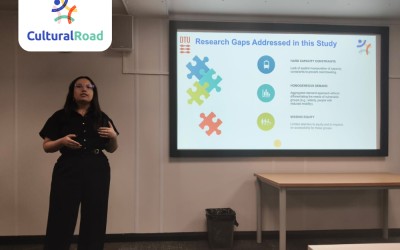CulturalRoad aims to ensure that Connected, Cooperative, and Automated Mobility (CCAM) solutions are equitable and benefit everyone, regardless of their socio-demographic characteristics or their geographic and/or cultural diversity. Placing equity at the core of its work, the project has identified five key pillars of mobility equity: Network Optimisation, Safety, Acceptance, Psychological Factors and Inclusivity. In this article series, we explore what each pillar means for mobility equity in the context of the project, starting with inclusivity and how CCAM can be designed to serve all users fairly.
What is inclusivity?
In CulturalRoad, the Inclusivity pillar encompasses a wide range of aspects to ensure equitable access to CCAM services, including accessibility, affordability, and digital accessibility, and the implementation of concrete measures to guarantee passenger security and data privacy.
Accessibility has become a central focus in transportation planning. It focuses on the ability of individuals to reach critical destinations such as workplaces, educational institutions, healthcare centres, and recreational facilities. Accessibility reflects the quality and diversity of reachable opportunities within certain “cost” limits, such as expenses, time, or comfort. Accessibility analyses provide a meaningful measure of transportation systems’ effectiveness and serve as a foundation to align land-use and transport policies. However, accessibility lacks a universal definition, with evolving interpretations including spatial distribution of opportunities, service availability, and individual perceptions, among others. CulturalRoad aims to define novel accessibility metrics for CCAM environments that account for cultural and geographical diverse needs.
Affordability is another crucial dimension of inclusivity. It does not only concern the financial cost of travel, but also the capacity of individuals and households to access necessary services and opportunities. Initial definitions of affordability focused on maintaining transport spending below a certain threshold of household income, while more recent ones added housing costs to the expenses. While these benchmarks helped frame early discussions, the choice of arbitrary cutoffs has led to unclear results. CulturalRoad will broaden the perspective beyond static cost metrics to include lived user experiences.
The extent to which CCAM services meet the requirements of people with special needs is another crucial aspect. Users with mobility limitations, visual or hearing impairments, and other physical constraints, face systemic obstacles in existing transportation networks. CCAM services must therefore integrate universal design elements such as low-floor vehicles, tactile navigation aids, multimodal announcements, and accessible control interfaces. Engaging users in co-design processes is key to proactively identify and address these barriers, an approach that CulturalRoad prioritises to promote equitable mobility.
In addition, CCAM systems increasingly rely on apps and automated platforms for trip planning, booking, and payment, placing people without the necessary skills, devices, or internet connectivity at risk of exclusion. This issue particularly affects older adults, low-income groups, and those with limited digital literacy. To meet equity standards, CCAM services must ensure digital accessibility. Different alternatives will be analysed under the CulturalRoad Inclusivity pillar, from the inclusion of voice support, multilingual options, offline or physical booking mechanisms, and simplified user interfaces, to specific trainings. Among others, the Inclusivity pillar specifically considers digital barriers linked to age, education, income, or lack of digital familiarity.
Finally, security and data privacy are also core components of the Inclusivity pillar. As the absence of human drivers in CCAM services redefines the landscape of passenger safety, new solutions to ensure user’s personal security need to be included. These are especially critical for protecting vulnerable users such as women, children, and the elderly, who may feel more exposed in driverless environments. Technological features such as onboard surveillance, emergency communications, AI-based incident detection, and remote operator intervention are potential measures to be implemented. CulturalRoad aims to rank the security measures that need to/might be included in CCAM services so that all users are and feel safe. The Inclusivity pillar will focus on the objective aspects of security, while people’s perceptions of safety will be explored through the Acceptance and Psychological Factors Pillars.
Ethical data use is equally important, as CCAM services rely heavily on collecting location data, travel history, biometrics, and communication logs. To build public trust, it is essential that users retain control over their data through transparent practices, opt-in consent, and adherence to strict data protection standards like the EU’s General Data Protection Regulation (GDPR). Design strategies should embed anonymisation, secure data storage, and minimal retention policies from the outset. Without clear privacy safeguards, concerns over surveillance and misuse could undermine user confidence and limit adoption. The Inclusivity pillar will define the measures that need to be implemented in order CCAM operators to respect user’s privacy and, thus, foster the adoption of CCAM systems.
Methodological framework
The variability of the dimensions covered by the Inclusivity pillar requires the use of different methodologies adapted to each of them. Novel Key Performance Indicators (KPIs) will be defined to assess the extent to which CCAM-based mobility solutions take these dimensions into account and, therefore, to what extent they are equitable. By appropriately combining these partial KPIs, an Inclusivity KPI that considers cultural, geographical and exogenous diversity will finally be proposed.
The project partners involved in the Inclusivity pillar are currently defining the methodologies to be used, at first based on existing methodologies to be adapted for application to CCAM environments and with an equity perspective. Examples of such methodologies and KPIs include location-based spatial-temporal accessibility analyses and cumulative opportunities, econometric analyses relating transportation expenditures and housing location to the socioeconomic level of individuals, or holistic multicriteria analyses combining quantitative and qualitative data that allow ranking measures or policies to be implemented in order to make CCAM services more equitable. In addition, we aim to define novel, CCAM-specific methodologies in further steps.
This methodological process is grounded in real-world contexts, where the various dimensions of Inclusivity already manifest in tangible ways. For instance, in Barcelona, accessibility maps by public transport (Figure 1) and income distribution maps (Figure 2) show interesting insights. In the first map, residents of the Pedralbes and Sarria-Sant Gervasi neighbourhoods (top left in Figure 1, in red and orange) are shown to have bad accessibility to healthcare centres. Based on accessibility alone, administrations could decide to prioritise investments in public transport (or in the implementation of public healthcare facilities) in this area. However, Figure 2 shows that the inhabitants of this area are the most affluent (blue colour, linked to the highest income deciles), with higher ownership and use of private vehicles, as well as of private insurance that allows them to visit personalised healthcare centres throughout the city. This highlights the need to develop more comprehensive methodologies for current mobility solutions, but even more so for future environments where CCAM services will be able to operate on demand.

“Mobility gives freedom. And freedom is a right. Therefore, all people, regardless of where they live, their socioeconomic level, their physical abilities, etc. should be able to make their daily commute and to access their essential activities without difficulty. CCAM as defined under the principle of Inclusivity can contribute to this objective.” Margarita Martínez Díaz, Associate Professor, Universitat Politècnica de Catalunya (Spain)
A collaborative effort
Research on the Inclusivity pillar is led by the Universitat Politècnica de Catalunya (UPC), in close collaboration with our academic partners (Technical University of Denmark, National Technical University of Athens, Technical University of Munich) to define the scenarios to be evaluated, with the partners in the demonstration sites (Autoritat del Transport Metropolità (ATM) , Oxfordshire County Council, Eilat Municipality, Karlsruhe and Regional Development Agency of Ljubljana urban region) to define methodologies that are applicable in practice and facilitate data acquisition, as well as with other industry partners with extensive experience in mobility and CCAM (IRF, ERTICO and FICOSA among others).



